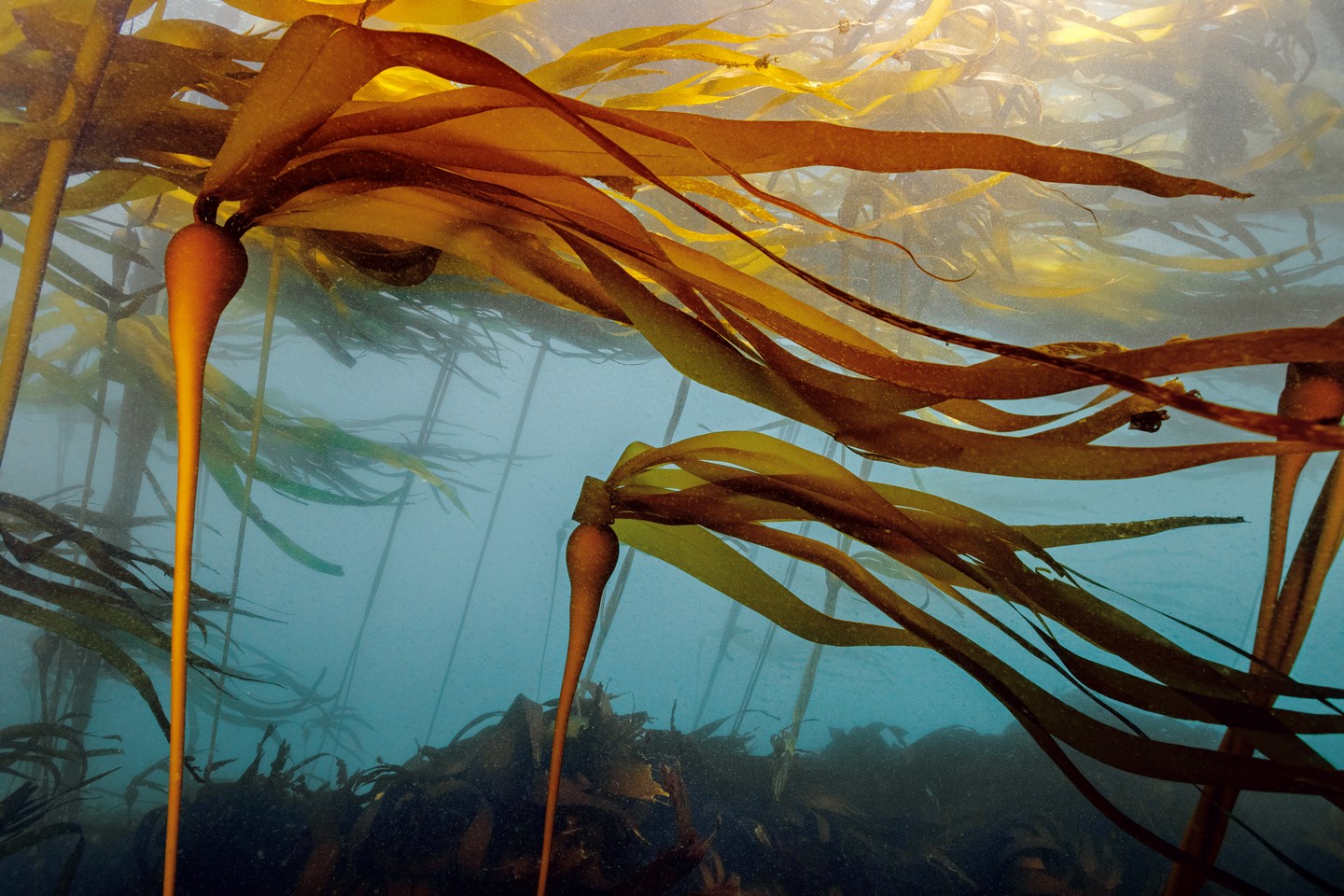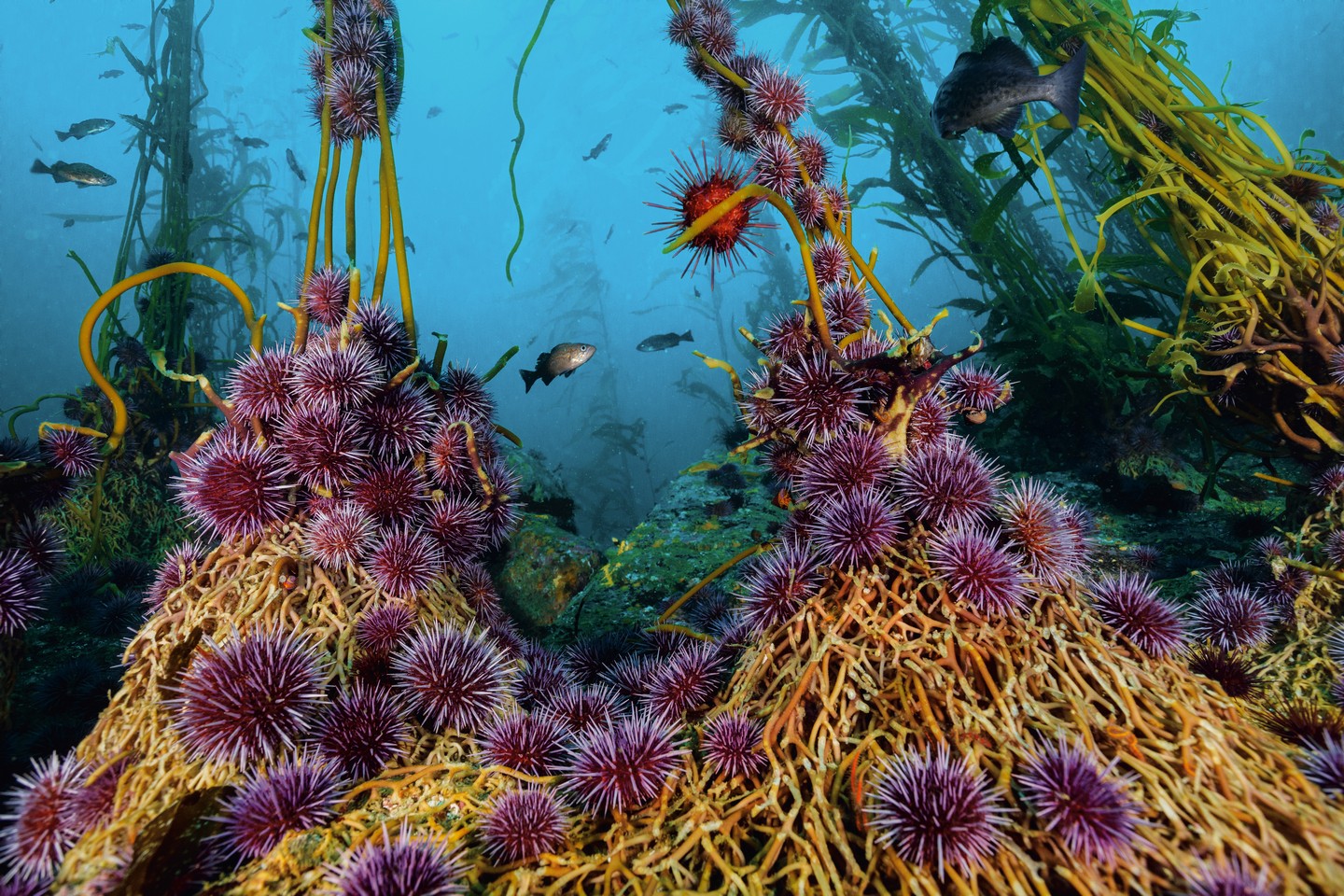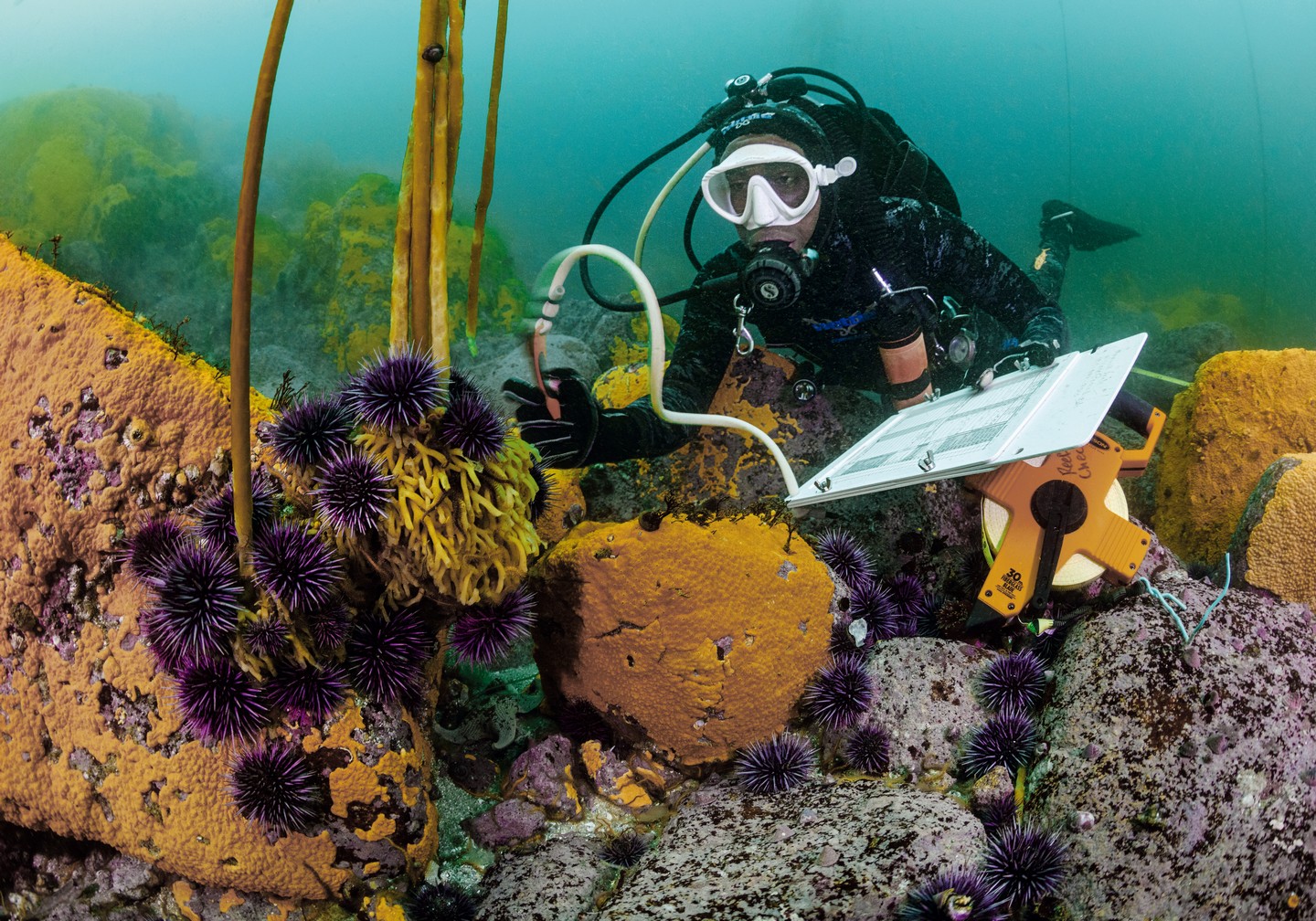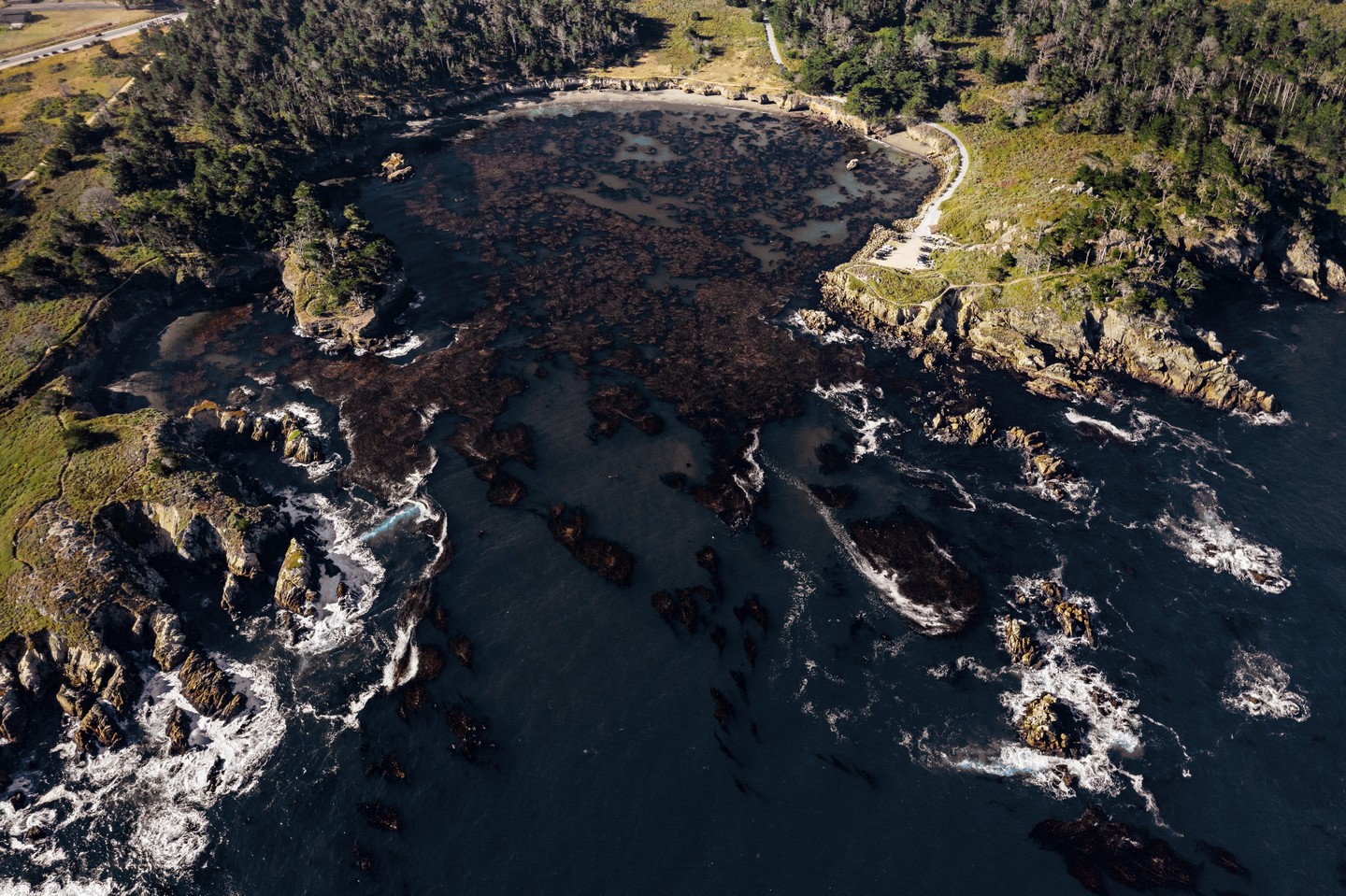Losing the World's Kelp
Text by Melissa Gaskill
Photos by Brandon Cole
Abridged by Syharn Shen (沈思含)
Losing the World's Kelp
Text by Melissa Gaskill
Photos by Brandon Cole
Abridged by Syharn Shen (沈思含)

Bull kelp off the coast of Oregon, USA. The amazing, tree-like plants float up to the surface, buoyed by air-filled bladders, with its fronds or blades creating a canopy. Much of the kelp along the coast of Oregon and California (northern and central) has disappeared.
There are some 30 different species of kelp, which are large brown algae, around the world. Bull kelp (Nereocystis luetkeana) grows off the Pacific coasts of Asia and North America, where it ranges from Alaska to California and grows on rocky surfaces at depths of 4 to 22 meters. Giant kelp (Macrocystis pyrifera) is found worldwide in nearshore temperate oceans, including the Pacific coast of North America and around Tasmania. Giant kelp grows in depths from 6 to more than 30 meters and, under the right conditions, can grow two feet a day.
Both bull and giant kelp have large, wide leaves with a tall central stalk and air bladders that help keep the stalk upright. Their leaves form a dense, floating canopy on the surface. Healthy kelp forest ecosystems are more productive than the Amazon rainforest and provide breeding grounds, food, and shelter for more than 1,000 species, including fish, invertebrates, mammals such as sea otters and seals, and diving and shorebirds. Kelp forests also sequester carbon, generate oxygen, absorb wave energy, and alter sedimentation flow, creating ecosystem benefits far beyond their borders. Loss of kelp has a profound effect on marine ecosystems.
The disastrous loss of kelp in the North American West Coast started about a decade ago with a rapid disappearance of sea stars, especially sunflower sea stars (Pycnopodia helianthoides). Three feet in diameter with up to 26 arms, this species is a keystone predator that eats purple urchins (Stronglyocentrotus purpuratus). In 2013, sea star wasting disease (SSWD) wiped out roughly 90 percent of the global population of sunflower sea stars. Scientists see no signs of recovery, and the International Union for Conservation of Nature (IUCN) listed the species as Critically Endangered in 2020.
Without sea stars to prey upon them, purple urchins exploded to population densities 60 times greater than their historical average. By 2015, urchin barrens—piles of the spiny creatures and little else—covered vast swaths of the sea floor. Urchins eat kelp, and armies of them gobbled up complete forests of it. The West Coast then experienced intense ocean warming from 2014 to 2017. Normally, upwelling of cold, deep water brings nutrients to the surface along this coast, but heat waves suppress this upwelling. The low nutrient conditions further stressed any kelp that survived the urchin onslaught. Scientists say kelp forests are extremely unlikely to recover without help. That help includes dealing with the urchins and bringing back sea stars.

Purple sea urchins feeding on giant kelp. The spiny invertebrates chew the kelp through its stalks. Only the holdfast (the spaghetti-like tangle of roots) remains, anchoring the kelp to the rocky substrate. Sea urchins are voracious feeders on kelps and other algaes.
Friday Harbor Labs at the University of Washington, supported by the Nature Conservancy, has been working on producing sunflower sea stars in captivity for the first time. Meanwhile, commercial fishermen and volunteer divers are stepping in to try and do the job of sea stars. Reef Check's Dan Abbott says a significant challenge is bringing urchin numbers low enough to allow kelp to recover. The goal is to bring balance back and restore a healthy ecosystem—for kelp, sea stars, urchins and everything else.
In Tasmania, about 150 miles off the southeast corner of mainland Australia, 95 percent of giant kelp forests have disappeared in the past few decades. In addition to ocean warming, the area's kelp also experienced changes in ocean currents—specifically the East Australian Current, which no longer delivers vital nutrients to this area. Urchin barrens became a problem as well, with the population of long-spined sea urchins (Centrostephanus rodgersii) estimated to have nearly doubled in the 15 years prior to 2016. The Australian government has listed giant kelp forests as an endangered marine community.
In August 2019, scientists at the University of Tasmania Institute for Marine and Antarctic Studies (IMAS) began testing giant kelp in the lab for heat tolerance. They sampled remnant stands of kelp found in the wild to identify genetic profiles that made them more tolerant of warm water, then collected spores to grow them in the lab. The idea is that using the hardiest genetic lines increases the chances of the success of restoration efforts.

Maxwell Seale with Reef Check California conducts a survey of marine life in a kelp forest on a rocky reef in Monterey Bay, California, USA.
"We hope this increased tolerance to warm water will increase their resilience to the ongoing ocean warming that is happening here, and which is largely responsible for the loss of the giant kelp in the first place," notes Cayne Layton, a researcher at IMAS. The team now has two patches of planted giant kelp, each about 100 square meters in size, where kelp planted 18 months ago have reached an average height of 3 meters and a maximum height of 12 meters. Each patch now contains reproductively mature adult kelp and the researchers hope to soon see the first natural juveniles produced by planted kelp.
The prognosis for kelp's future, according to Reef Check's Abbott, is "mixed." Some areas off the California coast are seeing slight increases in kelp coverage, while in others, urchin barrens continue to expand and have developed in new areas as well. But efforts to restore kelp continue to expand, too. Bottom line, however, all these efforts could be for naught unless society addresses the root cause of kelp loss: climate change. As Abbott says, "It's a lot easier to protect an existing forest than to restore one from a barren."

Point Lobos State Natural Reserve offers some of the finest scuba diving in California. Forests of giant kelp grow from rocky reefs and pinnacles in protected waters, supporting abundant fish and invertebrate species.
Contact Us | Plan a Visit | Donate
8 Lide Road, Beitou 11259, Taipei, Taiwan
886-2-2898-9999
005741@daaitv.com
©Tzu Chi Culture and Communication Foundation
All rights reserved.
